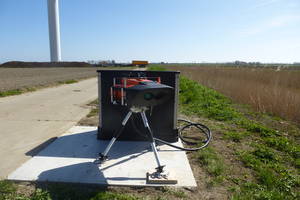ECN launches LiDAR Calibration Facility at ECN’s wind turbine test site
ECN has launched the LiDAR Calibration Facility, a world class facility for quick and efficient calibrations of ground-based LiDARs, nacelle LiDARs and also SoDARs.

Using LiDAR for turbine and windfarm measurements is becoming more accepted. In order to be bankable and trust worthy however, it is important to calibrate the LiDAR before and after the measurements are taken.
Any company using LiDAR or another remote sensing device can apply to have their system calibrated at this facility with superb wind conditions and world class infrastructure and measurement team.
What is remote sensing?
Traditionally, the wind is measured with cup anemometers in large meteorological masts. An alternative option to measure the wind is with remote sensors, like LiDARs (Light Detection and Ranging) or SoDARs (Sound Detection and Ranging). These are systems that measure the wind remotely, i.e. from the ground or from a turbine’s nacelle, making using of laser light or sound pulses. Their advantage is that they are easy to deploy, move and that they don’t need permits.
Why is a calibration facility needed?
Over the last decade remote sensing has gone through a huge development from prototype machines for R&D to robust systems for industry application. They are used for wind resource assessments, assessing the performance of wind farms and more recently as control systems. In order to secure high performance and high-quality data, it is essential to have such systems validated before using a system in actual field campaigns or before market entry of a new system. For this purpose ECN introduces its new calibration facility.
What is the calibration facility?
The ECN Remote Sensing Calibration Facility is a high-quality facility located in flat terrain with high yearly average wind speeds and excellent infrastructure. Central part of the facility is an IEC compliant meteorological mast of 100m instrumented with MEASNET wind tunnel calibrated anemometers. The facility offers a stable underground, easy power supply and network connection, theft protection and time synchronization with the meteorological mast.
Ground-based sensors are directly compared against the mast on horizontal wind speed and direction and for nacelle LiDARs a line of sight comparison is performed. Typical results of a validation campaign are: check on KPIs, an uncertainty assessment and a sensitivity assessment. Here, ECN is an ISO 17025 accredited institute.
